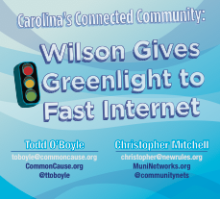
Fast, affordable Internet access for all.


Citywide Internet will soon be available as a monthly service in Port Angeles on Washington's Olympic Peninsula. Mayor Cherie Kidd, Police Chief Terry Gallagher, and Councilwoman Brooke Nelson participated in a ceremonial "cable cutting" event last week. The event was to celebrate the new network, nicknamed "The Mesh." Arwyn Rice, of the Olympic Peninsula Daily News covered the event in a recent article.
According to the Metro-Net website, a $2.6 million Broadband Technology Opportunity Program (BTOP) grant funded part of the $3.7 million Wi-fi system. The network serves a dual purpose, serving public safety first responders and a separate level for public access. From the News article:
The public safety system allows police officers to track each other through the city so that they know where their backup is without having to call radio dispatchers.
They also can do their own searches on driver's licenses and license plates, check recent call histories and access reports, said Officer Erik Smith, who demonstrated the use of the system in his patrol car.
Eventually, the system will be patched into the city's security cameras and police car dashboard cameras — and potentially Port Angeles School District security cameras — so that officers will be able to monitor situations at City Pier from their cars at Lincoln Park, said Police Chief Terry Gallagher.
“The limitation is our imagination,” Gallagher said.
While access is free through October 31, OlyPen MetroNet will start offering a variety of plans on November 1. Mobile and fixed-point service will be available and range from $5.95 (some sources say $4.95) for one day to $37.95 per month. Every user will receive the first hour of Internet access free each day.
As we have often found, the spirit of collaboration and determination on a local level helped realize this possibility:


In 2011, we brought you information about New Hampshire FastRoads, an open access project. At the time, the discussion centered around legislative events. We decided to look into the FastRoads project for an update.
The FastRoads project received partial funding from the Network New Hampshire Now (NNHN) project and its American Recovery and Reinvestment grants. Private donations and matching funds added to the $65.9 million budget to expand broadband across the state. The entire NNHN network planning includes middle- and last-mile fiber installations, along with a middle-mile microwave public safety network. The NNHN network will span ten counties, some of which are still relying on dial-up.
The FastRoads network will bring together 22 communities and 220 Community Anchor Institutions on the western side of the state. The project also includes last-mile networks in Rindge and Enfield and is expected to connect approximately 1,300 businesses and residents in those two towns, many who rely on dial-up.
In March, 2011, FastRoads began the first phase of the project when it awarded the design and project management contract to Design Nine. According to the Design Nine website, the fiber build- out will cover 25% of the entire state.
Shortly after hiring Design Nine, FastRoads released a Request for Qualifications (RFQ) for the building phase of the network. The contract went to Clemsford, Massachusetts' Waveguide last October.
Completion of the project is scheduled for June 30, 2013.
Arlington County, Virginia is taking advantage of a series of planned projects to create their own fiber optic network, ConnectArlington. The County is moving into phase II of its three part plan to improve connectivity with a publicly owned fiber network.
Some creative thinking and inter-agency collaboration seem to be the keys to success in Arlington. Both the County and the Arlington Public Schools will own the new asset. Additionally, the network will improve the County Public Safety network. Back in March, Tanya Roscola reported on the planing and benefits of the ConnectArlington in Government Technology.
Arlington County's cable franchise agreement with Comcast is up for renewal in 2013. As part of that agreement, the schools and county facilities have been connected to each other at no cost to the County. Even though there are still active negotiations, the ConnectArlington website notes that the outcome is uncertain. The County does not know if the new agreement will include the same arrangement. Local leaders are not waiting to find out, citing need in the community and recent opportunities that reduce installation costs.
Other communities, from Palo Alto in California to Martin County in Florida, have found Comcast pushing unreasonable prices for services in franchise negotiations. Smart communities have invested in their own networks rather than continue depending on Comcast.
Like schools all around the country, Arlington increasingly relies on high-capacity networks for day-to-day functions both in and out of the classroom. Digital textbooks, tablets, and online testing enhance the educational adventure, but require more and more bandwidth and connectivity. From the article:
Through ConnectArlington, Arlington Public Schools will be able to take advantage of Internet2 for distance learning. At no cost, students will be able to communicate with teachers and access electronic textbooks and online courses from wireless hot spots.
Chattanooga is once again using their municipally owned network to improve the quality of life and save money at the same time. New LED street lamps have been installed all over the City and the anticipated energy savings are expected to be significant. In addition to the obvious, saving money with more efficient LED lights, the City anticipates cutting costs in other ways associated with the change. From a recent Mary Jane Credeur Bloomberg Businessweek article:
Almost a third of Chattanooga’s annual energy bill comes from old high-pressure sodium streetlamps. At any given time 5 percent of the bulbs are burned out, and they sometimes go on during the day, needlessly adding to electric bills. “You’ve got a certain amount of lights out but you have no idea where they are, so workers literally drive around in a truck looking for them, and it’s a real waste,” says David Crockett, director of the city’s office of sustainability.
The change to LEDs is expected to cut energy use by 70%. City officials, however, have taken it one step farther and have installed a whole new system that will drive those savings up to 85%, or approximately $2.7 million. Global Green Lighting, a local company, developed a sophisticated lighting system using a wireless network that is fed by EPB Fiber. The system provides the ability to control each light's output 24/7 to tailor the level of light specifically to each lamp, the environment, the time of day, and even what might be happening on the ground. When a light is not working, it can self-diagnose and send a message to maintenance describing what is broken and what is required to fix it. There is no need for manual meter readers because energy usage reports back to the electric company via the network.
The community sees enhanced public safety from the new lighting. Prior to the install of the new system, Chattanooga had frequent criminal activity in several parks at night. Also from the Credeur article:
North Carolina infamously became the 19th state to enact barriers to community broadband, but we wrote about a loophole to it last year - communities can provide services for free without interference from the state capital. And starting last year, Newton, with 12,968 residents, began offering free Wi-Fi among 48 blocks and has plans to expand.
The city leaders were looking for ways to revitalize downtown. Jason Clay, the City IS Director, wanted to provide free outdoor WiFi as a way to get residents out and into the heart of the city. He had explored the possibility in the past, but the high cost was always a barrier. Initial estimates were between $50,000 and $150,000 to install free Wifi.
Clay put in time researching the products that would work for their situation. Rather than pay a consultant to do radio frequency and engineering studies, he did the work himself. By shopping directly with Meraki and Ubiquiti, Clay found significant savings. He even enlisted the help of the city's electrical crew and Information Services staff to install the needed devices. Where did they put the equipment? On city poles and water towers. Free WiFi in Newton is truly an initiative fueled by ingenuity, determiniation, and some elbow grease. From Joe DePriest's Charlotte Observer article written when the network went live:
"I knew the equipment was out there and that we had to find out which one fit our needs," Clay said. "So I kept digging and researching, trying to take the mystery out of it. When you take the mystery out of anything, it's usually just a lot of smoke and mirrors anyway. I kept at it. And we came up [with] some pretty cool stuff."
In a September city press release:
The lawsuit claims that, since at least July 2001, AT&T has filed monthly and annual reports listing fewer business phone lines than they actually provide. Under Tennessee law, phone companies must pay $3 per month per line to pay for 911 access. ... In a March phone service bid proposal for Hamilton County, AT&T stated it would not collect the $3 rate and instead collect $2 per line per month. That allowed the company to underbid the next lowest bidder by 69 cents per line per month, “unlawfully increasing its profits at the expense of revenue to support the critical emergency services that” 911 provided, according to court records.A difference of $.69 may not seem like much, until you consider they may be providing 1,000 lines - which is a difference of $690/month or $8,280/year.
 It is an incredible racket. AT&T gets more high-margin customers, pays less in fees than competitors, and the only people who get hurt are those who depend on 9-11.
Just when you think AT&T is brilliantly evil (an accusation I tend not to make against many corporations no matter how much I disapprove of their practices), you have to consider how incredibly incompetent they are.
It is an incredible racket. AT&T gets more high-margin customers, pays less in fees than competitors, and the only people who get hurt are those who depend on 9-11.
Just when you think AT&T is brilliantly evil (an accusation I tend not to make against many corporations no matter how much I disapprove of their practices), you have to consider how incredibly incompetent they are.In the place where “Texas history lives,” the City of Granbury followed a fellow Texas city in delivering a Tropos wifi system that covers all 10 square miles of the city. Less than a decade ago, Granbury had no functional IT department and after hurdles with a private public partnership, established a functional and successful publicly-owned wireless network. Initially created to support city functions and mobile police, the network is available to the public, elevating the rural town outside of Fort Worth to the mobile age.
When Granbury hired IT Director Tony Tull in 2003, the technology capabilities of the city were dire: no staff, a budget of $6,000, and only two buildings with access. Tull quickly brought city and council officials on-board to his ambitious technology plan to deploy wireless WAN to all city buildings in partnership with their existing ISP, Texas-based Frontier Broadband (now acquired by KeyOn). The initial needs were to equip city personnel with mobile access which focused on police officers, firefighters, and city inspectors.
Other goals included general public and tourist broadband access, reading utility meters, perform live web casts, and connect to nearby governmental networks. After the City received a Homeland Security grant, $70,000 was earmarked to outfit over 10 police vehicles with wireless laptops. In 2004 Tull attended the Public Technology Institute’s National Summit for Local Governments in Corpus Christi where he reviewed the city’s 147 square mile wireless network by Tropos. Convinced the technology was right, Granbury deployed a test run of 40 routers across half the city and eventually 100 more to cover the roughly 10 square miles.